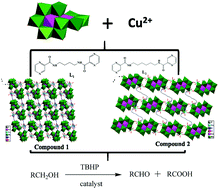Evans–Showell-type polyoxometalate-based metal–organic complexes with novel 3D structures constructed from flexible bis-pyrazine–bis-amide ligands and copper metals: syntheses, structures, and fluorescence and catalytic properties†
Abstract
Two new Evans–Showell-type polyoxometalate (POM)-based metal–organic complexes, namely {Cu3(L1)1.5(H2O)5[Co2Mo10H4O38]}·5H2O (1), {[Cu(L2)0.5(H2O)2]2[Co2Mo10H4O38]}·6H2O (2) (L1 = N,N′-bis(2-pyrazinecarboxamide)-1,4-butane, L2 = N,N′-bis(2-pyrazinecarboxamide)-1,6-hexane), were successfully synthesized and structurally characterized by single-crystal X-ray diffraction, elemental analysis, IR spectroscopy, powder X-ray diffraction (PXRD) and thermogravimetric analyses (TGA). In complex 1, the adjacent [Co2Mo10H4O38]6− polyoxoanions are linked by CuII ions to form a 1D Cu–[Co2Mo10H4O38]6− inorganic chain, which is further linked by ligand L1 and [Co2Mo10H4O38]6− polyoxoanions, forming a 3D metal–organic framework. In complex 2, the adjacent [Co2Mo10H4O38]6− polyoxoanions link the CuII ions to generate a 2D Cu–[Co2Mo10H4O38]6− inorganic layer, which is further connected with bidentate ligands L2 to obtain a 3D metal–organic framework. The structural diversities of compounds 1 and 2 showed that the spacer lengths of the flexible bis-pyrazine–bis-amide ligands play important roles in tuning the structures of the title complexes. Compounds 1 and 2 represent the first examples of 3D frameworks based on the Evans–Showell-type polyoxoanions and Cu-bis-pyrazine–bis-amide coordination complexes. Moreover, the ligand L1 was first successfully introduced into the POM system. The electrochemical and fluorescence properties of compounds 1 and 2 were discussed. As heterogeneous catalysts, compounds 1 and 2 have good catalytic activity for the oxidation of benzyl alcohol. Moreover, compound 2 has higher catalytic performance with 100% conversion and 98.0% selectivity for benzoic acid at 10 h. The difference in their catalytic performance may be mainly due to the difference of their structures. The catalysts can be recovered and reused without displaying any significant loss of activity.



 Please wait while we load your content...
Please wait while we load your content...